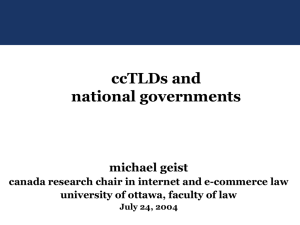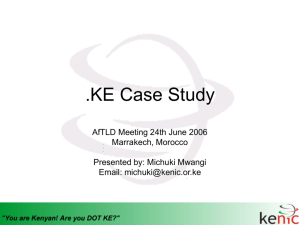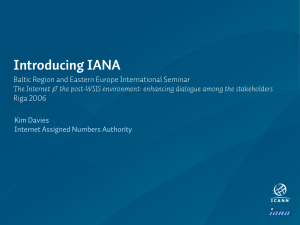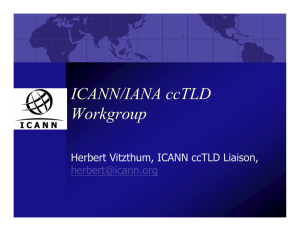GOVERNMENTS AND COUNTRY-CODE TOP LEVEL DOMAINS: A GLOBAL SURVEY Version 2.0 February 2004
advertisement
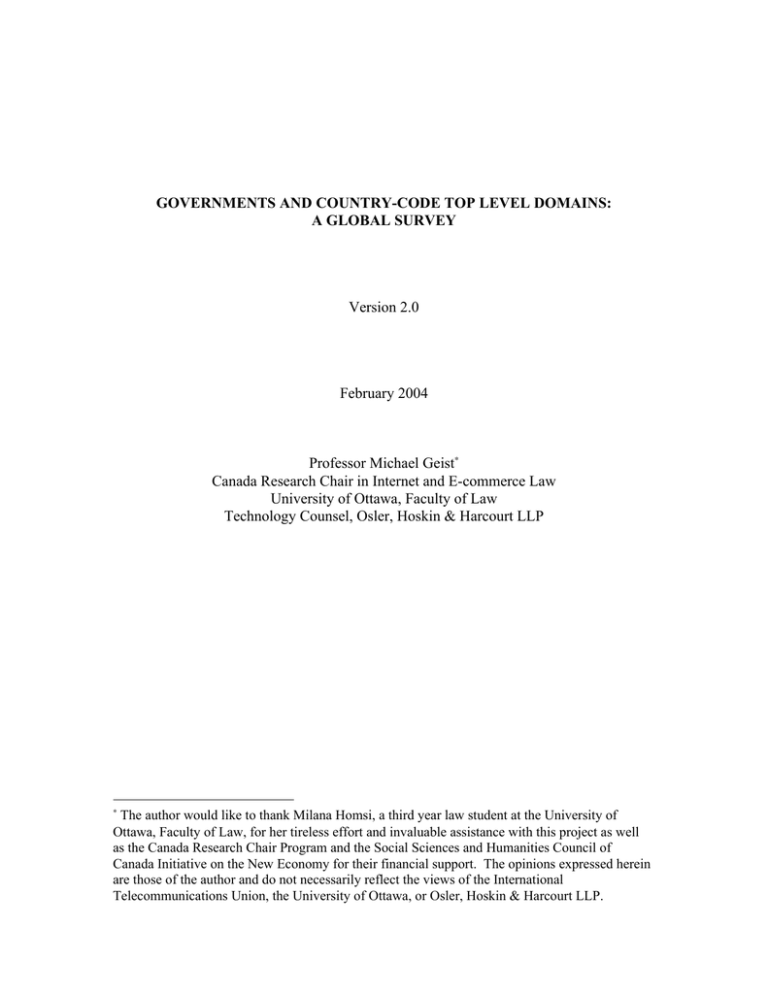
GOVERNMENTS AND COUNTRY-CODE TOP LEVEL DOMAINS: A GLOBAL SURVEY Version 2.0 February 2004 Professor Michael Geist∗ Canada Research Chair in Internet and E-commerce Law University of Ottawa, Faculty of Law Technology Counsel, Osler, Hoskin & Harcourt LLP The author would like to thank Milana Homsi, a third year law student at the University of Ottawa, Faculty of Law, for her tireless effort and invaluable assistance with this project as well as the Canada Research Chair Program and the Social Sciences and Humanities Council of Canada Initiative on the New Economy for their financial support. The opinions expressed herein are those of the author and do not necessarily reflect the views of the International Telecommunications Union, the University of Ottawa, or Osler, Hoskin & Harcourt LLP. ∗ Executive Summary In April 2003, Professor Michael Geist and the Telecommunications Standardization Bureau of the International Telecommunications Union launched a survey of all 189 ITU member states on the role of national governments within their domestic top-level domain. The survey featured questions on the current legal role of ccTLD administrators, ccTLD policies, and governmental involvement in national and international Internet governance issues. A preliminary version summarizing the survey’s key findings was released in November 2003. This updated version now covers results from 66 countries that responded to the survey as of February 2004, representing every global region as well as a broad cross-section of developed and developing countries. Key findings of survey respondents include: • Governments are deeply involved in domain name administration at the national level. Contrary to most expectations, virtually every government that responded either manages, retains direct control, or is contemplating a formalized relationship with their national ccTLD. • 43 percent of responding governments retain ultimate control over their national ccTLD. A further 30 percent have taken specific steps toward asserting ultimate authority over their national ccTLD. Nineteen percent of respondents indicated that they were considering formalizing their relationship with their ccTLD and expected that relationship to change in the future. Only seven percent of respondents indicated no formal governmental role in their ccTLD with no plans to alter the present situation. • While the survey reveals increasing consensus among respondents on the need for national governments to assert a proprietary interest in their national ccTLD, it also uncovers striking differences in the commercialization of ccTLDs. • In a question canvassing policy priorities, responding countries with public ccTLDs consistently ranked the public interest and the protection of intellectual property rights as top priorities, while the number of domain name registrations was viewed as the least critical priority. As the ccTLDs move toward increasing commercialization, the data suggests that priorities begin to invert as the public interest and intellectual property protection diminish in importance, while the number of domain name registrations increase in priority. • The data suggests a direct correlation between the pursuit of the public interest and the imposition presence requirements for domain name registration purposes. • Commercial ccTLDs are more likely to offer immediate online registrations than their public counterparts. 2 • The survey found no substantial correlation between the organizational type of the ccTLD and the adoption of dispute resolution or WHOIS policies. Background The issue of Internet governance has gained increasing prominence in recent years as the importance of an effective and efficient domain name system becomes ever more apparent. While much of the focus has centered on the operations of the Internet Corporation for Assigned Names and Numbers (ICANN), the role of national governments has sometimes been overlooked. As the proportion of ccTLD domain name registrations continues to grow -- recently reaching 38% of all domain names worldwide -- the question of the role of national governments within the administration of national domain names has moved to the forefront. In April 2003, Professor Michael Geist and the Telecommunications Standardization Bureau of the International Telecommunications Union prepared a circular to be distributed to all 189 ITU member states.1 TSB Circular 160 was designed to increase global understanding of the role of national governments within their domestic top-level domain. It featured questions on the current legal role of ccTLD administrators, ccTLD policies, and governmental involvement in national and international Internet governance issues. A copy of the circular is attached as Appendix Two to this report. An addendum to the policy was issued in July 2003, extending the deadline for return of the survey to 30 October 2003.2 The relationship between Professor Geist and the ITU on this project is properly characterized as one of cooperation for data collection purposes. The ITU agreed to use its large network of member states to distribute the survey and collect the data. Professor Geist and the ITU agreed to share the data to be used in their own respective ways. This updated report, which includes additional survey results since the release of a preliminary report in November 2003, highlights the most significant findings arising from an analysis of the results of the survey. The opinions expressed herein are personal to Professor Michael Geist and do not necessarily reflect the views of the International Telecommunications Union. Sixty-six countries responded to the survey as of February 2004. The respondents were primarily governmental or ccTLD representatives.3 While a complete list of respondents is listed at Appendix One, it is noteworthy that the respondent pool features countries from every global region as well as a broad cross-section of developed and developing countries. Notwithstanding the wide array of respondents, it is possible that the governments that responded have ccTLD policies that are different from those 1 http://www.itu.int/md/meetingdoc.asp?type=sitems&lang=e&parent=T01-TSB-CIR-0160. Id. 3 In addition to the 66 governmental responses, one ccTLD manager from Germany also provided a response. That response is not included in the overall statistical findings. 2 3 governments that did not respond. Accordingly, given the roughly 35 percent response rate, non-response bias cannot be ruled out and the survey’s findings should be considered as valid only for the respondents, not for all governments. Key Findings 1. Governmental Role in ccTLD Oversight The appropriate governmental role in the management and oversight of the domain name system is an increasingly contentious issue. At the global level, the domain name system is administered by ICANN, a California non-profit corporation. While ICANN enjoys support from the United States government as well as the governments of several other developed countries, many countries worldwide have begun to voice the view that all governments should share in the administration of the domain name system. Largely absent from the Internet governance debate in the late 1990s, they have awoken to its importance and have sought to place the issue firmly on the global agenda. The push for greater governmental involvement in the domain name system has many critics, however. Reflecting the popular notion that the Internet’s remarkable growth has come largely without governmental regulation, critics of increased governmental participation in Internet governance believe that the domain name system is best left to a decentralized self-regulatory approach. The most significant finding of this global survey is that, at least at the national level, governments are currently deeply involved in domain name administration. In fact, contrary to most expectations, virtually every government that responded to the survey either manages, retains direct control, or is contemplating formalizing its relationship with its national ccTLD. This is true even for governments, such as the United States, that generally adopt a free-market approach to Internet matters. Given the nearubiquitous role of government at the national level, it should therefore come as little surprise that governments have begun to seek a similarly influential role at the international level where policy decisions may have a direct impact on their national domains. Figure One illustrates the current role of governments at the national level. Forty-three percent of survey respondents indicated that they retain ultimate control in one of four ways. First, many governments directly operate the national ccTLD as part of a government ministry or agency. Second, some governments have established a subsidiary company of a government ministry or agency to manage their ccTLD. Third, several governments have enacted legislation granting themselves final authority over their ccTLD’s operations. Fourth, a number of governments have entered into operational contracts with their national ccTLD manager in which they assert their ultimate authority over the ccTLD, but grant their approval to a non-governmental ccTLD manager. 4 A further thirty percent of survey respondents indicated that they had taken specific steps, including drafting legislation or creating a commission to consider legislation, toward asserting ultimate authority over their national ccTLD. An additional nineteen percent of respondents indicated that they were considering formalizing their relationship with their ccTLD and expected that relationship to change in the future. In fact, only seven percent of respondents indicated no formal governmental role in their ccTLD with no plans to alter the present situation. a move towards formalization no plans 7.46% consideration or discussion of formalizing 19.40% specific steps towards formalized relationship 29.85% government run or subject to agreement/legislation 43.28% Figure One 5 2. Differing ccTLD Priorities – Commercialization vs. the Public Interest While the survey reveals increasing consensus on the need for national governments to assert a proprietary interest in their national ccTLD, it also uncovers striking differences in the commercialization of ccTLDs. These differences are manifested in the organizational structure of national domain name administrators. As illustrated in Figure Two, the survey found that among respondents 41 percent of ccTLDs are structured as non-profit corporations or organizations, 20 percent are structured as for-profit commercial enterprises, 14 percent are public institutions, and 20 percent are operated by academic institutions or individuals.4 organizational types public institutions, 13.6% non-profit organizations, 40.9% academic institutions or individuals, 19.7% for-profit commercial enterprises, 19.7% Figure Two The significance of organizational structure is illustrated by several additional findings that focus on: • • • • ccTLD priorities restrictions on domain name registration through presence requirements relative speed of ccTLD registrations emerging policy issues such domain name dispute resolution and WHOIS policies. 4 Statistics do not equal 100% as one country indicated that it is both a public and academic institution. 6 a. ccTLD Priorities One of the most difficult survey questions was a request for respondents to rank their ccTLD’s policy priorities. Respondents were given nine priorities to consider and asked to rank the priorities from one to nine, with one being the most important priority and nine representing the least important. The nine priorities were: 1. Efficiency of the domain name system 2. Preservation of the public interest in the domain name system 3. Ease of domain name registration 4. Transparency and accountability in ccTLD management 5. Protection of intellectual property rights 6. Low cost of registration 7. Alignment with the government's general telecommunication policy or other policies 8. The local Internet community's cooperation in the ccTLD management 9. Registration size of the TLD While several respondents, declined to answer the question, 85 percent of respondents provided their rankings. The responses revealed significant differences in priorities depending upon organizational type. As Figures Three and Four demonstrate, countries with public ccTLDs consistently ranked the public interest and the protection of intellectual property rights as top priorities, while the number of domain name registrations was viewed as the least critical priority (the lower the aggregate number, the higher the priority). As the organizational type moved toward increasing commercialization, the data suggests that priorities begin to invert as the public interest and intellectual property protection diminished in importance, while the number of domain name registrations increased in priority. Countries with commercial ccTLDs were also collectively the least likely to answer the priorities question. While all countries in which ccTLDs are public organizations responded to the question, as did 94 percent of countries in which there are academic and individual ccTLD managers, only 64 percent of countries in which ccTLDs are commercial organizations specified their policy priorities. 7 Type Commercial Non-Profit Academic/Ind. Public Size 6 5.9 6.1 7.8 Efficiency 3.6 2.4 3.2 2.9 Public Interest 4.6 2.9 2.9 2.6 Figure Three priorities by organizational type priorities Size IP Efficiency Public Interest 0 1 priority rating 2 Non-profit 3 Academic 4 5 Commercial 6 7 8 Public 9 Figure Four 8 IP 5.4 3.6 3.9 3.8 b. Public Interest and Presence Requirements Survey respondents were asked whether their ccTLD actively pursues the public interest and whether the ccTLD has established restrictions on domain name registration that limit access to the domain to only those registrants who comply with national presence requirements. The data in Figure Five illustrates noticeable differences between countries with public or commercial ccTLDs. While 77 percent of countries with public ccTLDs report that they actively pursue the public interest, only 54 percent of countries with commercial ccTLDs report a similar position. Moreover, the data suggests a direct correlation between the pursuit of the public interest and the imposition of presence requirements for domain name registration purposes. Eighty-eight percent of countries with public ccTLDs report imposing some form of presence requirements on domain name registrants, while only 54 percent of countries with commercial ccTLDs impose a similar requirement. These findings are consistent with the differing prioritization discussed above – the overwhelming majority of countries with public ccTLDs appear willing to forego larger registration numbers in favour of the protection of the public interest, with the public interest seemingly defined to include limitations on registrations designed to preserve the national character of a ccTLD. public interest by organization type individual actively pursue public interest public academic other presence requirements non-profit local presence requirements commercial 0% 50% Figure Five 9 100% c. Speed of Registration In keeping with their more commercial approach, it comes as little surprise to find that countries with commercial ccTLDs are more likely to offer immediate online registrations than their public counterparts. As Figure Six illustrates, 62 percent of countries with commercial ccTLDs compete with generic TLDs such as dot-com and dotorg by offering immediate online registrations, compared with only 22 percent of countries with public ccTLDs. Email registration is the favoured approach for 33 percent of countries with public ccTLDs, perhaps reflecting the more onerous registration requirements that may require manual or offline review. speed of registration by organizational type 0% individual 100% 0% 11% public 33% 22% mail/fax email 18% academic immediate online 18% 27% 22% non-profit 36% 44% 39% commercial 23% 62% Figure Six 10 d. Cutting Edge Issues – Dispute Resolution and WHOIS The survey asked respondents to report on whether their ccTLD had adopted a dispute resolution policy or a policy addressing WHOIS data. The results found no substantial correlation between organizational type and the adoption of these policies. Countries with non-profit ccTLDs were the most likely to have adopted a dispute resolution policy (51 percent), followed by countries with commercial ccTLDs (39 percent), academic ccTLDs (36 percent), and public ccTLDs (33 percent). By contrast, 76 percent of countries with academic ccTLDs adopted a WHOIS policy, followed by both 63 percent of countries with public and non-profit ccTLDs and 55 percent of countries with commercial ccTLDs. 11 Appendix One – Survey Respondents Australia Botswana Burkina Faso Cambodia Canada Chile China Costa Rica Cyprus Czech Republic Denmark Ecuador Egypt España Estonia Finland France Germany Greece Hong Kong, China Indonesia Iran Italy Jamaica Japan Jordan Kenya Kuwait Kyrgyzstan Lesotho Lithuania Luxembourg Madagascar Malaysia Mauritius Mexico Monaco The Netherlands New Zealand Niue Norway Oman Pakistan Peru 12 Portugal Republic Of Armenia Republic Of Korea Republic Of Macedonia Republic Of Singapore Republica Dominicana République Démocratique Du Congo. Romania Seychelles Slovak Republic Suriname Sweden Switzerland Tanzania Thailand Trinidad and Tobago Uganda Ukraine United Kingdom United States Zambia 13 APPENDIX TWO I NTERNATIONAL T ELECOMMUNICATION U NION Telecommunication Standardization Bureau Geneva, 24 April 2003 Ref: TSB Circular 160 COM 2/RH Tel: Fax: +41 22 730 5887 +41 22 730 5853 tsbsg2@itu.int E-mail: - To Administrations of Member States of the Union Copy: - To ITU-T Sector Members; - To ITU-T Associates; - To the Chairman and Vice-Chairmen of Study Group 2; - To the Director of the Telecommunication Development Bureau; - To the Director of the Radiocommunication Bureau Subject: Questionnaire on Member States' experiences with ccTLDs Action: Please return the questionnaire by 30 June 2003 at the latest Dear Sir/Madam, 1 The issue of Internet governance has gained increasing prominence in recent years as the importance of an effective and efficient domain name system becomes increasingly apparent. While much of the focus has centered on the operations of the Internet Corporation for Assigned Names and Numbers (ICANN), the role of national governments has sometimes been overlooked. As the proportion of ccTLDs continues to grow, recently reaching 38% of all domain names worldwide, the question of the role of national governments within the administration of national domain names has moved to the forefront. 14 2 In conformity with ITU Plenipotentiary Conference Resolution 102 (Marrakesh, 2002), the Director of TSB organized a Workshop on Member States' Experiences with ccTLDs (Geneva, 3-4 March 2003). The workshop documents are at: http://www.itu.int/itudoc/itu-t/workshop/cctld/index.html The report of the workshop can be found at: http://www.itu.int/itudoc/itu-t/workshop/cctld/cctldrep.html A summary of the input documents is available at: http://www.itu.int/itudoc/itu-t/workshop/cctld/059r1.html 3 Reviewing the input documents, and in particular document 6 by Professor Michael Geist of the University of Ottawa, it appears that it would be useful to collect additional information from member states regarding their experiences with ccTLDs. 4 Therefore, TSB and Professor Geist have prepared the questionnaire which is attached hereto and which I would kindly request you to complete. This survey is designed to increase global understanding of the role of national governments within their domestic top-level domain. It features questions on the current legal role of ccTLD administrators, ccTLD policies, and governmental involvement in national and international Internet governance issues. The survey and collected data is being jointly administered by the Telecommunication Standardization Bureau of the ITU and professor Geist's ccTLD Governance Project. Only the Administration representing the Government of your country should reply to this questionnaire, and replies should reach the TSB by 30 June 2003 at the latest. The results will be published in a further circular as soon as all replies have been received 5 I would like to stress the importance of this questionnaire, which will enable a comprehensive and complete view of Member States' experiences with ccTLDs to be collected and published. I therefore count on your active co-operation in ensuring that your reply is as full as possible and that it reaches me by the prescribed deadline. Yours faithfully, H. Zhao Director of the Telecommunication Standardization Bureau Annex: 1 15 ANNEX (to TSB Circular 160) Please return this questionnaire, duly completed, to the following address: Telecommunication Standardization Bureau/ITU Place des Nations CH-1211 Geneva 20 (Switzerland) Fax: +41 22 730 5853 E-mail: tsbsg2@itu.int Reply to the questionnaire on Member States' Experiences with ccTLDs Name of your Administration: ................................................................................................ ccTLD code: ............................................................................................................................ Country: ................................................................................................................................... Contact person: ........................................................................................................................ Tel.: ............................................................. Fax.: .................................................................. Email: .................................................................................................................................... Instructions: Please fill out the following questions either on this survey or in a separate document to the best of your knowledge. See page 11 for definitions of terms used in this survey. I GOVERNMENT-CCTLD ISSUES: A. Government involvement in the domain 1) How does government involvement or non-involvement manifest itself in your country’s ccTLD? [Please indicate the situation(s) which best describe(s) your ccTLD and provide details] θ Is there direct control of the ccTLD? θ Is the ccTLD part of a government ministry? θ Is the ccTLD a subsidiary company of a government agency or ministry? θ Is there a formal contract between the government and the ccTLD? θ Is there an ongoing, formal relationship between the government and the ccTLD? θ Has there been a governmental endorsement of the ccTLD’s role and management? θ Is there an informal, unofficial or ad hoc relationship between the government and the ccTLD? θ Is there no relationship between the government and the ccTLD? Details: 16 2) Are there any plans to change the situation? [If so, please indicate which situation you expect would prevail in the future.] θ Yes? θ No? 3) What is the status of government-ccTLD relations? [Please indicate the situation(s) which best describe(s) your ccTLD and provide details] θ Is there legislation that grants the government ultimate authority over the ccTLD? θ Has the government made recent efforts to: θ Pass legislation that affects the ccTLD? θ Establish a commission or body to examine ccTLD management or legislation? θ Speak in parliament, a national legislature, in public or in other circumstances about ccTLD management issues? θ Consider formalizing the ccTLD-government relationship? θ Does your country’s ccTLD make decisions independently of the government? Details: 4) Are there any plans to change the situation? [If so, please indicate which situation you expect would prevail in the future.] θ Yes? θ No? 5) Which government agencies are responsible for government-ccTLD relations? [Please indicate the situation(s) which best describe(s) your ccTLD and provide details] θ Telecommunications regulatory body? θ Ministry of Telecommunications? θ Ministry of Science and/or Technology? θ Ministry of Justice? θ Other? Details: 6) Are there any plans to change the situation? [If so, please indicate which situation you expect would prevail in the future.] θ Yes? θ No? B. Internet Governance Participation 1 ) Does the government send a representative to or otherwise participate in meetings of the Government Advisory Committee (GAC) of the Internet Corporation for Assigned Names and Numbers (GAC)? [If not, please provide details] 17 θ Yes? θ No? 2) Does the government or ccTLD send a representative to or otherwise participate in ICANN meetings? [If not, please provide details] θ Yes? θ No? 3) I. Please indicate whether there are contracts between the government and ICANN and/or the ccTLD and ICANN: θ Between ICANN and the government? θ Between ICANN and the ccTLD? II. Please indicate the key factors that contributed to the ccTLD or government deciding to formalize the relationship. III. Did any impediments arise in formalizing this relationship? θ Yes? θ No? II CCTLD STRUCTURE & POLICIES: A. General 1) What kind of structure best defines the ccTLD? [Please indicate the situation(s) which best describe(s) your ccTLD and provide details] θ A commercial enterprise θ A non-profit corporation or organization θ A public entity θ An academic entity θ Operated by an individual Details: 2) How does your country’s ccTLD meet its operating costs? [Please indicate the situation(s) which best describe(s) your ccTLD and provide details] θ Through registration fees θ Through membership fees θ Through government contributions θ Voluntarily run TLD θ The domain is commercially run by an out-of-country entity θ Other – please provide details Details: 18 B. Board composition If your ccTLD has a board of directors or advisors, please give details about the following: 1) What is the size of the board? 2) Is there public participation in the nomination or voting process for board members? [If yes, please provide details] θ Yes? θ No? Details: 3) If there is government involvement on the board, what role does it play? θ Chairperson θ Voting member in a government capacity θ Voting member in a personal capacity θ Non-voting member in a government capacity θ Non-voting member in a personal capacity 19 C. General ccTLD policy 1) Please rate the following objectives of your ccTLD from 1 to 9, where most important is 1 and least important is 9. — Registration size of the TLD — Low cost of registration — Ease of registration — Efficiency of domain name system in your country — The local Internet community’s cooperation in the ccTLD management — Preservation of the public interest in the domain name system — Align with the government’s general telecommunication policy or other policies — Protection of intellectual property rights — Transparency and accountability in ccTLD management 2) Has the board/executive had any consultations in the past three years about the future policy direction or structure of the ccTLD? [If yes, please explain or provide references.] θ Yes? θ No? Details: 3) Are the ccTLD’s goals and objectives consistent with your country’s telecommunication policy? [Please provide details or references]. θ Yes? θ No? Details 4) Does your ccTLD actively pursue the public interest in the domain name system in your country? [Please provide details or references]. θ Yes? θ No? Details: 20 D. Policy making approach 1) How does/has your ccTLD formulate its policies? [Please indicate the situation(s) which best describe(s) your ccTLD and provide details or references] θ Through public consultations θ Through public elections θ Through government initiatives or directives θ Through board of directors θ Through employee/manager initiatives Details: 2) Who supervises and/or approves the policies (apart from general supervision by anti-trust authorities)? θ ccTLD itself (no external supervision apart from anti-trust authorities) θ Government agency θ Other [pleases explain] E. WHOIS policy 1) Has your country’s ccTLD established a WHOIS policy that addresses public access to registrant information? [If yes, please provide details or references] θ Yes? θ No? Details: F. Dispute Resolution Policy 1) Has your country’s ccTLD implemented a domain name dispute resolution policy? θ Yes? θ No? 2) If yes, is the policy: θ A national implementation of the ICANN UDRP θ A Country-specific policy modeled on the ICANN UDRP [please give details] θ A Country-specific policy unlike the ICANN UDRP θ Based on the ccTLD best practices for the prevention and resolution of Intellectual Property disputes published by the World Intellectual Property Organization (WIPO) 21 3) If your country’s ccTLD has implemented a domain name dispute resolution policy, who provides the dispute resolution services? θ Local commercial arbitration providers θ International commercial arbitration providers θ ccTLD conducts its own θ Government or non-profit service G. Internationalized Domain Names (IDN) policy 1) Does your country’s ccTLD have a policy on IDN? [If yes, please provide details or references] θ Yes? θ No? Details: III Commercial issues: 1) Does your country’s ccTLD have local presence requirements or restrictions for registration? [If yes, please provide details or references] θ Yes? θ No? Details: 2) Does your country’s ccTLD have other restrictions on registration? [If yes, please provide details or references] θ Yes? θ No? Details: 22 3) What registrar model does your country’s ccTLD employ? θ Only the ccTLD can register domains θ A subsidiary of the ccTLD manages domain registration θ The ccTLD has contracted out the registration of domains to a single company θ The ccTLD has contracted out the registration of domains to multiple registrars θ The ccTLD operates a competitive and open reseller model 4) What is the price for ccTLD domain registration in your country? [Please indicate the cost of a one-year registration] 5) Are there different registration prices for non-residents? θ Yes? θ No? 6) Who supervises and/or approves the prices for ccTLD domain registration in your country (apart from general supervision by anti-trust authorities)? θ ccTLD itself (no external supervision apart from anti-trust authorities) θ government agency θ other [please provide detail] 7) How fast is your country’s ccTLD registration process? [Please indicate the situation(s) which best describe(s) your ccTLD and provide details] θ We provide immediate online registration θ We have an email-based registration process θ We have a mail-in/fax registration process θ We verify each registration individually to confirm it meets all registration requirements IV ccTLD Background: 1) Please provide any additional documentation, url references, or other information that is relevant to the ccTLD in your country. We would in particular appreciate any available information on the historical development of your ccTLD. 23 V Definitions: TLD: Top Level Domain - refers to the suffix attached to Internet domain names [Example: The org in www.icann.org]. ccTLD: Country Code Top Level Domain – where the suffix attached to the domain name refers to a country. [Example: The ca in www.canada.ca]. gTLD: Generic Top Level Domain – refers to the non - country code TLDs such as .com, .org, .net .biz, .edu. GAC: The Government Advisory Committee of ICANN which is comprised of appointed representatives of national governments. Its function is to advise the ICANN Board on matters of concern to governments. WHOIS: A database which contains registration information about any given domain name, including who registered it, when it was created and who to contact at that domain. UDRP: ICANN’s Uniform Domain-Name Dispute-Resolution Policy which is applied by registrars in the .aero, .biz, .com, .coop, .info, .museum, .name, .net, and .org top-level domains to resolve disputes before a registrar will cancel, suspend, or transfer a domain name. IDN: Internationalized Domain Names – standardizing and translating non-roman symbols and language so that it can be resolved by the existing domain name system. Presence requirements and restrictions: Many TLDs require registrants to meet certain conditions in order to be able to register a domain name. [Example: .us requiring registrants to be U.S. citizens or residents; .fi requiring registrants to be registered trademark holders in Finland]. ________________ 24
